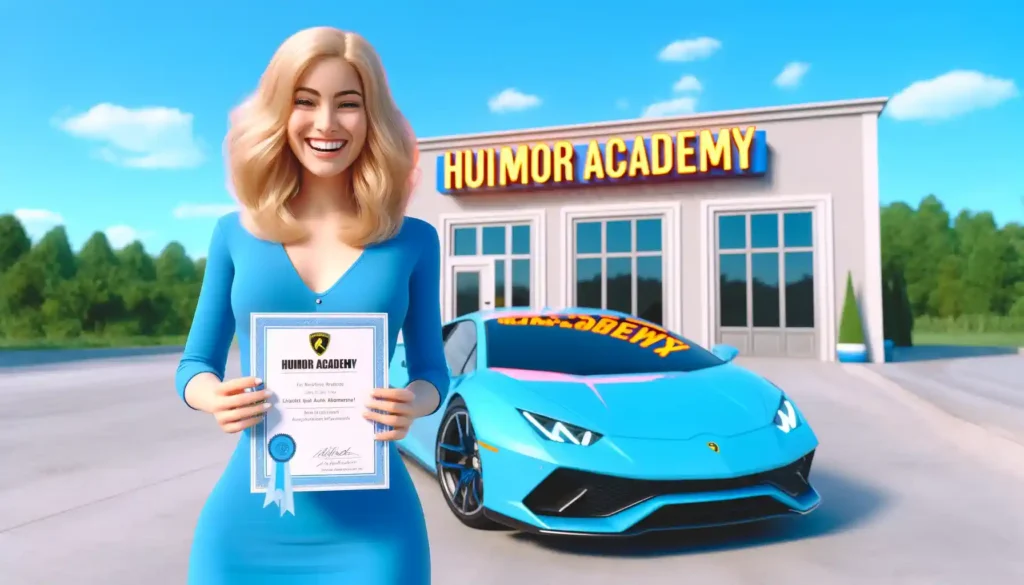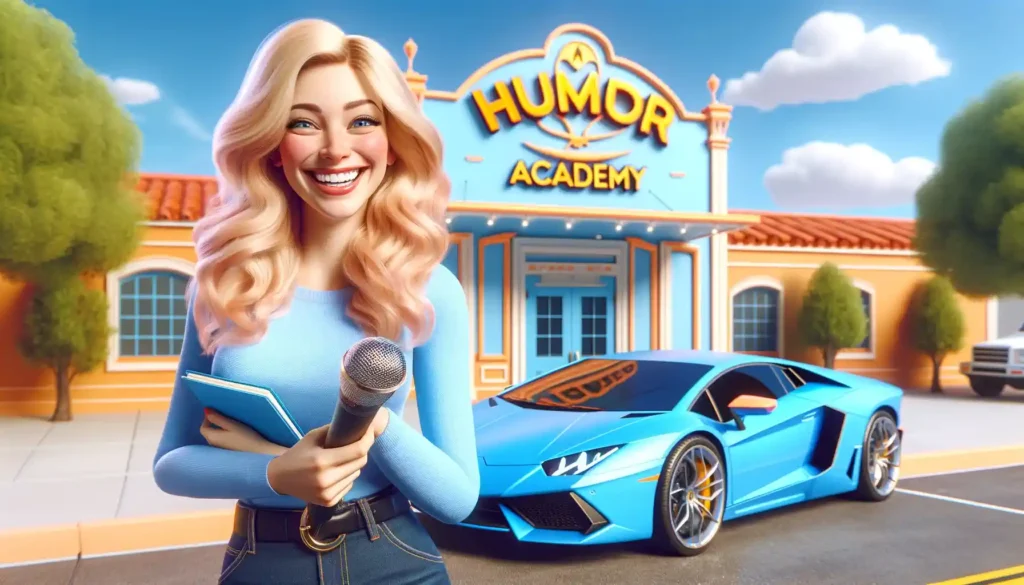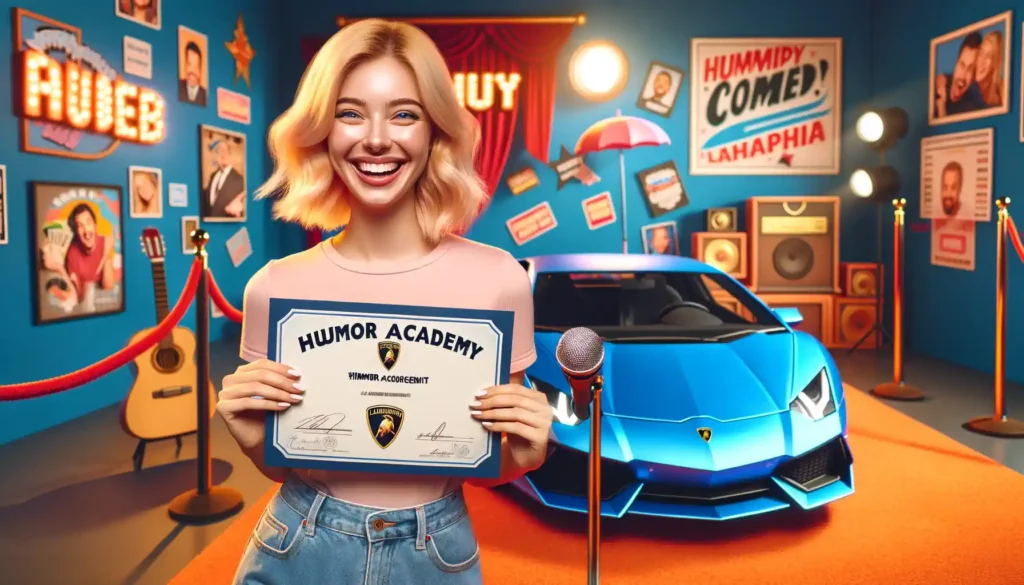Why Do We Need Humor?
The Humor Academy course is designed to take you on a hilarious journey through the world of humor, from understanding the fundamentals of comedy to mastering the art of delivering a punchline.

Imagine a World Without Humor
Imagine life without humor. It would be like a party with no music, a sandwich with no filling, or a cat with no memes. Yikes!
Humor Academy: The Trusty Sidekick
Humor is our trusty sidekick. It’s the friendly neighborhood Spider-Man of human interaction, swooping in to save the day when things get awkward. It’s the ultimate peacekeeper, capable of defusing tense situations faster than you can say “knock-knock.”
Humor: The Key to Building Strong Social Connections
Let’s face it, we need humor everywhere! At work, it’s that secret ingredient that makes meetings less dreadful. With friends, it’s the glue that keeps the gang together. And when dealing with strangers? A good joke is the fastest way to turn a frown upside down.

Humor in the Workplace
Picture this: You’re at a stressful meeting. The tension is thicker than your grandma’s oatmeal. Then, someone cracks a joke. Suddenly, the mood lightens, and the impossible task feels doable. That’s humor at work!
Personal Benefits of Humor Academy
And let’s talk about the personal benefits. Having a sense of humor is like having a superpower. It makes you more attractive – ask any woman, and she’ll tell you humor is a top three quality in a guy. It’s no secret that girls love a guy who can make them laugh. And guys, let’s be real, earning laughs is much more rewarding than earning points in a video game.
Navigating Life’s Hurdles
Humor also helps you navigate life’s hurdles with a smile. A person who can laugh at themselves and their problems is practically unstoppable. They’re the ones who face life’s curveballs with a grin and a clever one-liner.
Humor Academy Career Booster
Even in the workplace, humor is a career booster. Who wouldn’t want to work with the person who makes Mondays bearable? Managers love employees who can lighten the mood and foster a positive work environment. A well-placed joke can be as refreshing as a cool breeze on a hot day.
The Timeless Accessory
Humor keeps you young, modern, and forever cool. So, if you want to stay vibrant and connected, keep your humor game strong.
Unleashing the Power of Laughter
In this course, we’ll dive deep into the mechanics of humor, unraveling how it works and why it makes us laugh. You’ll master the basic techniques of comedy, understanding what makes a joke land and what sends it crashing. We’ll explore topics that are fair game for jokes and those that are strictly off-limits. Get ready to flex your funny bone and pump up those humor muscles until you’re a comedic powerhouse!
The Boundless World of Humor
Our main mission? To open the door to the vast, limitless world of humor. We want to immerse you in this world so deeply that you’ll feel like you’re swimming in a sea of laughter, comfortably riding the waves of wit. By the end of this course, you’ll have not only improved your sense of humor but also learned how to sprinkle humor into your daily life like a seasoned comedian.
From Novice to Knockout
Even if you’ve never cracked a joke before, fear not! This course will take you from zero to a comedic hero. You’ll learn to joke better, funnier, and more effectively than ever before. And if you’re already a joke master, we’ll help you refine your skills to a razor-sharp edge. Get ready to use humor to make your life more interesting, entertaining, and filled with good vibes.

Awakening Your Inner Comedian
Everyone has a sense of humor, whether it’s barely there, moderately developed, or sky-high. This course is designed to awaken and enhance that sense of humor within you. You’ll gain the knowledge and tools to unleash your creativity, mental agility, and comedic talent, turning you into a joke-spinning machine.
Developing Your Humor Muscles
A sense of humor can be developed and improved—just ask any top comedian or stand-up comic. With a bit of effort, practice, and a lot of laughs, you’ll be able to use humor effectively in your everyday life. Life happens every second, and with the right comedic skills, you can make it funny at every turn.
The Essentials of Joking with Humor Academy 2.0
Many people want to joke but don’t know where to start. That’s where we come in! We’ll provide you with a solid theoretical and practical foundation. You’ll learn when and how to joke, what types of jokes are appropriate, and how to deliver your punchlines flawlessly. Understanding your audience and timing will become second nature to you.
Proven Comedy Techniques
All the information in this course is 100% reliable, derived from the experiences and analyses of professional comedians who’ve been in the industry for over 15 years. To master the art of joking, you’ll need to complete all the tasks and exercises in this course diligently. Practice makes perfect, and your effort will be rewarded with sharper wit and quicker humor reflexes.
Go the Extra Laugh
Don’t just settle for the minimum—push yourself! If an exercise asks you to come up with five jokes on a specific topic, go for fifteen. Choose the best ones and hone your skills further. Your dedication will pay off, making you the go-to person for laughs in any situation.
How to Create a Stand-Up Monologue with the Best Humor Tricks

Creating a stand-up monologue is both an art and a science. It involves understanding the audience, crafting relatable content, and using humor techniques effectively. Here’s a comprehensive guide on how to create a stand-up monologue with the best humor tricks.
1. Develop Your Comedic Voice
Find Your Persona
Your comedic persona is an exaggerated version of yourself. It could be sarcastic, self-deprecating, observational, or absurd. Consistency in your persona helps the audience connect with you.
Write What You Know
Draw from personal experiences, observations, and opinions. Authenticity resonates with audiences and lends credibility to your humor.
2. Crafting the Stand Up Monologue like a Pro after Humor Academy

Start Strong
Open with a strong, attention-grabbing joke. A solid opener sets the tone and engages the audience from the get-go.
Use the Rule of Three
The rule of three is a classic comedy principle: set up a pattern with the first two items and break it humorously with the third.
Build Punchlines
Ensure your jokes have clear punchlines. A punchline is the twist or unexpected part of the joke that delivers the humor. It should be concise and impactful.
Use Callbacks
A callback refers to bringing back a joke or reference from earlier in the monologue. This technique rewards attentive listeners and creates a sense of continuity.
Top 15 Humor Techniques to Create Jokes and Make Laughter

Creating jokes is an art form that involves various techniques to craft humor that resonates with different audiences. Whether you’re want to become a stand-up comedian, a writer, or someone who loves to make people laugh, understanding these humor techniques can help you create more effective and memorable jokes. Here are the top 15 humor techniques to create jokes:
1. Exaggeration
Description: Exaggeration involves overstating certain aspects of a situation, character, or event to a ridiculous extent. Example: “I’m so hungry, I could eat a horse. And maybe a zebra for dessert.”
2. Irony
Description: Irony involves saying the opposite of what you mean, often to highlight the absurdity of a situation.
3. Sarcasm
Description: Sarcasm is a form of irony where the speaker’s tone indicates that they mean the opposite of what they are saying, often in a mocking manner. Example: “Sure, I love getting stuck in traffic. It’s my favorite part of the day.”
4. Self-Deprecation
Description: Self-deprecation involves making fun of yourself to show humility and connect with the audience. Example: “I’m on a new diet. It’s called ‘the see-food diet’—I see food, and I eat it.”
5. Wordplay
Description: Wordplay involves using puns, double entendres, and other linguistic tricks to create humor.
6. Observational Humor
Description: Observational humor focuses on the funny aspects of everyday life and common experiences. Example: “Isn’t it weird that we have a ‘snooze’ button? We’re basically setting an alarm to tell us when to set another alarm.”
7. Callbacks
Description: A callback is a joke that refers back to a previous joke or reference in the routine, creating a connection and rewarding the audience for paying attention. Example: After a joke about a friend’s bad cooking, later saying, “At least it’s not like Jim’s lasagna.”
8. Surprise
Description: Surprise humor involves leading the audience to expect one thing and then delivering something completely different. Example: “I told my wife she was drawing her eyebrows too high. She looked surprised.”
9. Rule of Three
Description: The rule of three involves listing two normal items followed by a third that is unexpected or funny. Example: “I need to buy milk, eggs, and a new sense of self-worth.”
10. Incongruity
Description: Incongruity involves presenting something that doesn’t fit with the established pattern, leading to humor through the unexpected. Example: “Why don’t scientists trust atoms? Because they make up everything.”
11. Parody
Description: Parody involves imitating someone or something in an exaggerated way to create humor. Example: “If Shakespeare wrote cooking instructions: ‘To bake or not to bake, that is the question.'”
12. Anecdotal Humor
Description: Anecdotal humor involves telling a funny story or incident from personal experience. Example: “Last week, I locked myself out of my house. My dog was inside, looking at me like, ‘Who’s the smart one now?'”
13. Character Humor
Description: Character humor involves creating a humorous character with exaggerated traits or flaws. Example: “My uncle is so cheap, he brings his own popcorn to the movies—popped, from home, in a plastic bag.”
14. Physical Comedy
Description: Physical comedy relies on exaggerated movements, facial expressions, and body language to create humor. Example: Slipping on a banana peel in an exaggerated, theatrical manner.
15. Blue Humor
Description: Blue humor involves using risqué or controversial topics to create humor. It’s important to know your audience well when using this type of humor. Example: “They say laughter is the best medicine. Unless you have broken ribs, then it’s a really bad idea.”
Combining Techniques
The most effective jokes often combine multiple humor techniques. For instance, a joke might use exaggeration and wordplay together, or combine observational humor with self-deprecation.
Example: “I joined a gym and immediately lost 10 pounds. I wasn’t actually working out—I just misplaced my membership card.”
3. Structure and Timing
Set Up and Punchline
The setup introduces the scenario or premise, while the punchline delivers the comedic twist. Ensure there’s a clear distinction between the two.
Timing and Pacing
Effective timing and pacing are crucial. Allow pauses for laughter, and don’t rush through your jokes. Practice to find the right rhythm.
Transitions
Smooth transitions between jokes keep your monologue cohesive. Use segues to connect different jokes and maintain the flow of your performance.
4. Edit and Refine
Test Your Material
Perform your monologue in front of friends, at open mics, or at smaller gigs. Pay attention to which jokes land and which don’t.
Revise and Rework
Based on feedback, revise your jokes. Tighten setups, enhance punchlines, and remove any material that doesn’t resonate with the audience.
5. Delivering Your Monologue
Confidence
Confidence is key. Even the best material can fall flat if delivered hesitantly. Believe in your jokes and perform with conviction. humor academy will help you with that.
Body Language
Use body language and facial expressions to enhance your delivery. Physical comedy can add another dimension to your monologue.
Engage with the Audience
Interact with the audience to create a sense of connection. Acknowledge their reactions and adapt your performance if needed.
6. Handling Tough Crowds
Stay Calm
Not every audience will be receptive. Stay calm and composed, and don’t let negative reactions throw you off.
Have Backup Material
Prepare extra jokes or stories in case your primary material isn’t working. Flexibility can help you win over tough crowds.
Enroll In Humor Academy to Write your Stand Up Monologue

Learn humor techniques for Creating a stand-up monologue with a combination of writing, timing, and performance skills. By knowing the best humor techniques, developing your comedic voice, and using effective humor techniques, you can craft a monologue that is both funny and engaging.

